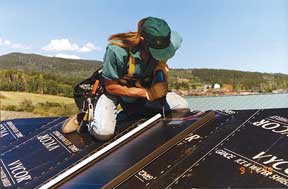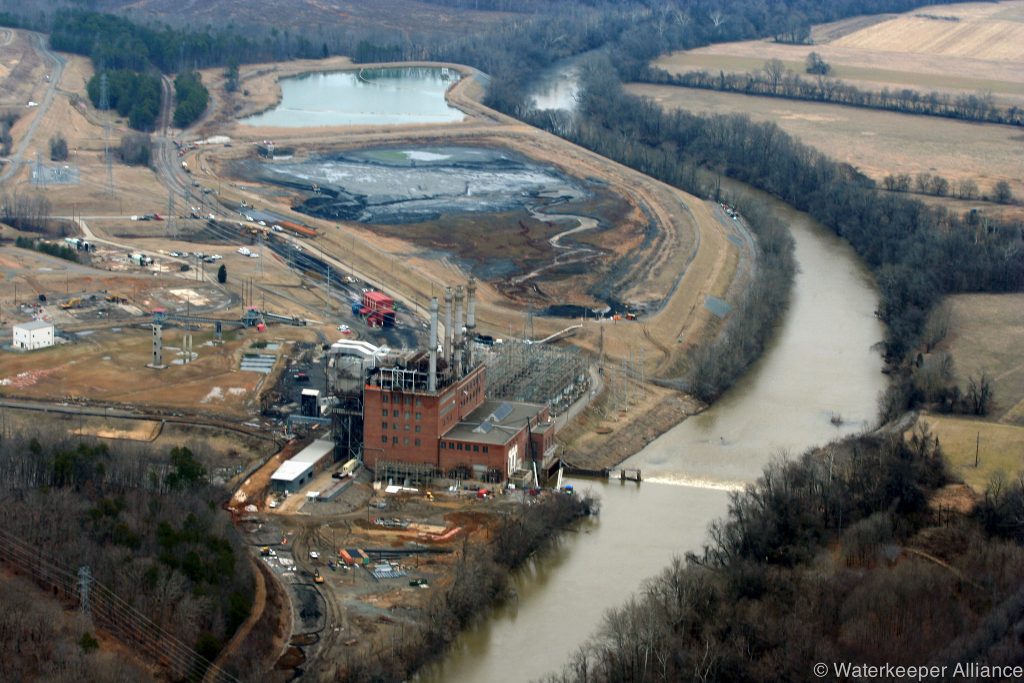Green Collar Jobs
Sustainable Jobs for the Appalachian Future
Story by Gregory McNamee

Windmills rise above the fog at Buffalo Mountain wind farm in Tennessee. Photo by Chris Irwin, United Mountain Defense
A quarter-century ago, a friend of mine moved from Wytheville, Virginia, to southern Arizona to take a job in an emerging, fast-growing field: installing rooftop photovoltaic panels to take advantage of the desert’s one great abundance, solar energy.
He flourished—briefly.
Then, for reasons that political historians have yet to explain, the Reagan administration abolished the tax credits for investment in renewable energy. My friend was soon out of a job.
From time to time, particularly when I want to work myself into a lather, I think what might have happened had we not lost that quarter-century of green-energy innovation.
Ah, well. The fact is, even with all those lost years, we are far ahead of where we were when I first entered the job market, in the dimly receding days of Watergate. That era saw the introduction of the term “energy crisis.” The economy was in the tank, too. We heard well-meaning pleas to conserve, to save, and to adopt alternate fuels and technologies. We had a junk-bond debacle, a savings-and-loan scandal, terrorist attacks, and failed pension funds. We saw astronomically rising healthcare costs, massive job losses, and a turbulent market that suffered a 45 percent decline in a single year.
In short, things were just about as they are now.
The difference is that now we seem to be truly serious about doing something about all the messes we’re in, particularly on the energy front. If that is true, then–for all the scary news on the economic front–this seems to be a very good time to be alive—or, at least, a very good time to be coming into the renewable-energy job market. For, once now-frozen credit starts to thaw and infrastructure-development funds start to flow, green jobs will open up in every region of the country, and will demand an educated workforce to fill them.
For the last several years, businesses have been talking green, so to speak. Now, by virtue of economic necessity and consumer demand alike, they’re acting on the talk. Organic food production—definitively more energy-efficient than the old industrial model—is no longer exotic. Neither are wind turbines, solar panels, hybrid cars, all of which will become ever more commonplace in the coming years. For its part, the Obama administration projects the addition of something on the order of 2.5 million green jobs in the workforce in the next three years.
Broadly speaking, there are three categories of renewable-energy, green-collar jobs, though these categories are not found in the classified ads.
The first comprises jobs of the present: work, in other words, that seeks to improve the way we do things now, that seeks to enhance present technologies. Amory Lovins, the renewable-energy guru, is exemplary here; much of the work of his Rocky Mountain Institute goes to consulting with manufacturers to realize efficiencies in production by what Lovins calls “doing more with less through smarter technologies.” Doing more with less means weatherproofing homes to stop heat loss, installing more efficient industrial motors, retrofitting vehicle fleets to burn biodiesel—all jobs that require engineers, analysts, mechanics, builders, and planners. The savings to be realized by implementing such changes are huge; by some estimates, with more efficient procedures and technologies in place, we can reduce our consumption of electricity by as much as 75 percent, for which reason energy efficiency figures prominently in President Obama’s energy program (and for which reason energy management is likely to be a booming field in the coming years).
The second comprises jobs of the future, and they are myriad. West Virginia’s Community Wind Initiative, for example, is seeking to replace coal consumption with wind energy, a task that will require workers of all kinds, from technicians and electricians to energy evangelists and even lawyers. The largest solar array in history is being erected in the California desert—and, apart from the grayer skies, there’s no good reason why a cousin facility should not be erected in the Valley of Virginia. The mountains of Appalachia are also rich in possibilities for geothermal-energy development. Construction materials are becoming ever greener, and architects and builders who can put those materials to use on the micro and macro levels are in very short supply.
The third comprises jobs of the past—interrogating history and custom for more efficient ways of doing things. In Appalachia, as elsewhere, people lived greener a century ago than they do now: food was produced in gardens and not trucked in from afar, wood was burned instead of propane, and so forth. I would like to think that any comprehensive approach to renewable energy will find room for folklorists, oral historians and others who can help identify what Gary Snyder calls “the old ways”—the ones that worked, and that deserve to be remembered and revived.
All of these jobs require smart, hardworking, well-trained and well-educated young people, and in that we are blessed with wealth. All of these jobs are, in one form or another, going to be available to the young people of Appalachia, just as, in one form or another, they are going to be available to young people everywhere on the planet. The future is unwritten, but it is upon us, and those young people have a bright future ahead—assuming, of course, that the world holds together long enough for us to band together to fix it.
The spirit is willing, the politics in alignment, and the need for green approaches increasingly self-evident, so that, even as we argue whether nuclear energy should be part of the mix or whether coal gas is a viable avenue of development, every niche in the ecology of the economy and of the workforce is looking to become ever more sustainable, ever more dependent on green solutions.
– – – – – – – – – – –
Gregory McNamee is the author of over a dozen books on environmental and cultural topics, including Careers in Renewable Energy: Get a Green Energy Job (2008); Moveable Feasts — The History, Science, and Lore of Food (2008); The Desert Reader (2003); and others). He lives in Tucson, AZ, but says he increasingly finds himself drawn to Appalachia.
Related Articles
Latest News

Leave a comment
Your email address will not be published. Required fields are marked *





